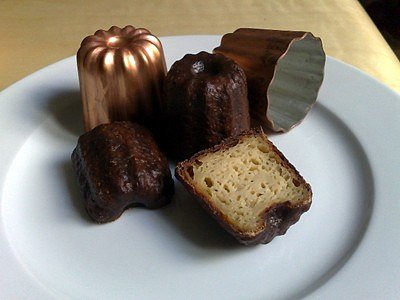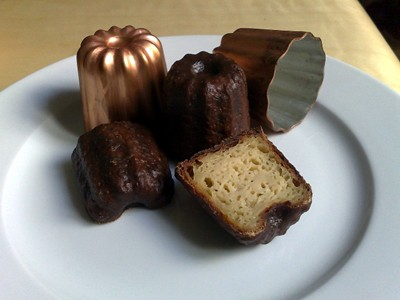Cannelés

Mon 1 Mar 2010

Though irrefutably Bordelais, the little cakes known as cannelés have conflicting origin stories. One attributes their development to a group of nuns. A more sentimental spin credits resourceful Bordeaux residents, who scooped up flour spilled from sacks during unloading at the port and used it to make the cakes for impoverished children.
Cannelés have a reputation for being difficult to make, and I’m not going to completely debunk that notion here. The batter is simple enough. What’s challenging is achieving the proper texture—that caramelized crust encasing a creamy vanilla- and rum-scented interior—that makes a cannelé a cannelé and not just any other cake.
Traditionally, copper molds are coated with “white oil,” a mixture of beeswax and vegetable oil that helps develop the crust while ensuring easy unmolding. If you are deterred by the use of hot wax in a recipe (I know I am), fear not: I found that a generous buttering did the trick, and any cakes that didn’t immediately release were easily coaxed out with a toothpick.
Less traditionally, you can use flexible silicon molds, which guarantee easy release. Like any nonstick surface, silicon doesn’t seem to encourage the kind of caramelizing that is characteristic of the best cannelés, but if you are willing to sacrifice a small amount of crustiness for greater ease, then the flexi-molds are for you.
I prefer the copper molds myself. Yes, they are more expensive (about 7 euros apiece at E. Dehillerin), but they are beautiful and will last forever.
Before you begin, there are a few things you should know:
The batter MUST rest at least a full 24 hours before baking, and I actually had my best results with batter that was two full days old. If you bake prematurely, you will get something resembling a popover.
If the exposed tops begin to darken before the baking time is up (and they will), cover the cakes with a sheet of foil to prevent burning.
If you are concerned that your oven’s thermostat is inaccurate, invest in an oven thermometer before attempting these.
Finally, don’t be discouraged if your first batch doesn’t come out. Cannelés can throw even experienced bakers for a loop.
Cannelés
Makes 12.
2 cups (500 ml) whole milk
2 tablespoons (30 g) butter
1 vanilla bean
¾ cup (100 g) all-purpose flour
¾ cup plus 2 tablespoons (180 g) sugar
pinch of salt
1 egg
1 egg yolk
3 tablespoons (45 ml) dark rum
A few tablespoons melted butter for the molds (not necessary if you’re using silicon molds)
1. Put the milk and butter into a small saucepan. Split the vanilla bean and scrape the seeds into the milk, and add the pod too. Gently heat the milk over medium heat until the butter has melted and the milk is steaming hot but not boiling. Remove from the heat and cool slightly.
2. In a mixing bowl, whisk together the flour, sugar and salt. Add the egg and yolk and whisk until thoroughly combined. Slowly add the milk to the egg and flour mixture, whisking constantly. Stir in the rum. Let the batter cool to room temperature, then cover it and refrigerate for at least 24 hours (and up to three days) before baking. (Leave the vanilla bean pod in the batter but fish it out before baking, obviously).
3. If you are using metal molds, grease them thoroughly with melted butter, making absolutely certain that every surface is thoroughly coated (I use a finger); then turn them upside down so that any excess butter doesn’t pool at the bottom of the molds. Refrigerate the molds until you’re ready to bake.
4. Put an oven rack in the lower third of the oven and preheat to 400°F (200°C). When the oven is ready, pour the batter into the molds, to about ½” (1¼ cm) from the top. Put the molds on a baking sheet and place in the oven. After 15 minutes, reduce the heat to 375°F (190°C) and continue baking for another 75–90 minutes, depending on how dark you want the cannelés to be. If the tops start to get too dark before the baking time is up, cover the cakes with a piece of foil.
5. If you’ve used copper molds, grab each mold with a towel and whack it against the counter a few times to loosen the cake. If the cakes don’t slide out when inverted, use a toothpick to loosen them from the molds. If you’ve used silicon, wait about five minutes before unmolding—they should pop right out.
Serving Suggestions
Let the cannelés cool completely before eating. They will hold for a few days in an airtight container at room temperature, though the crust will lose some crispness. Five minutes in a 400° oven will refresh them. Cannelés can be eaten for breakfast, a snack or dessert, with coffee, tea or a glass of wine.